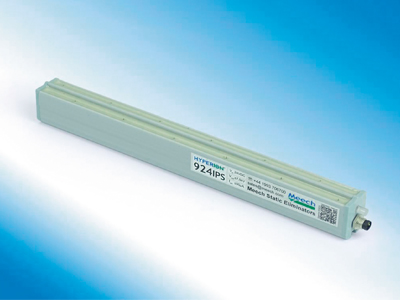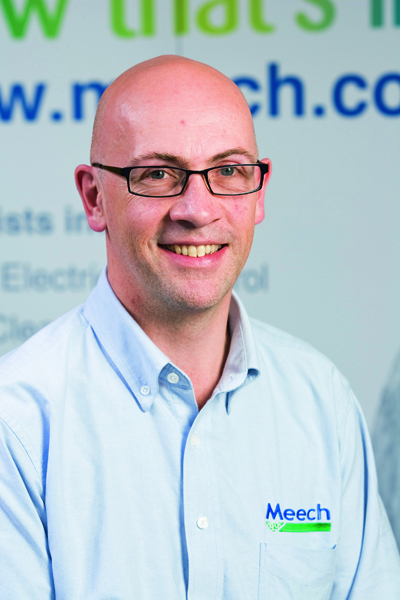Simon Eccles looks at the particular problems of static and humidity in digital print working, and some of the systems that help to solve them.
For digital printers, static electricity has its plusses and minuses. Lame joke aside, it is true. Statically charged substrates are vital to the operation of dry toner printers, and they can help inkjets to work better. Indeed the term ‘electrophotography’ is a combination of the terms ‘electrostatic printing’ and photography. Static also builds up on inkjet droplets in flight, which is a factor in how they interact with the substrate as they hit it.
Static where you do not want it is less good. The movement of paper from a roll or stack, through a press and across rollers inherently creates static on the surface. This can make sheets stick together and is a leading cause of double sheet feeds and jams in the feed or delivery. If there is static in the substrate as it reaches the delivery stacker, this may gum up the works downstream in a finishing machine.
‘Toner printers use static when you want it and take it away when you don’t,’ points out Graham Dawson. His company, ArrowGSD Technical Sales, is the UK sales agent for Arrowquint, which does a lot of work with static control for the printing sector. It distributes the German Eltex static control systems. ‘The press manufacturers are able to control the static inside their own machines. It’s what happens afterwards that may be a problem. Most of the static issue is immediately post-press. We’ve done a lot of work with the delivery end of digital presses. If the paper is loaded with static it can affect the finishing. It doesn’t stack, it’s hard to knock up, so it really does create problems for the next process. That’s where we tend to leap in and alter things.
‘We’re a solutions house – we provide solutions to problems. Inside the press there don’t tend to be problems because they’ve been sorted out at the manufacturer level. But where the manufacturer got it wrong, or forgot something, or put the cheapest thing inside, which frequently happens, we tend to take it off, throw it away and put something better on.’

The Hyperion 924 IPS compact ionising bar
Where static comes from
Electrophotographic processes apart, paper handling is the prime cause of static, and the prime sufferer from its effects. Static specialist Fraser Anti-Static Techniques lists four main causes of static in the print process: contact and separation between two materials – including friction, travelling over rollers etc; a rapid heat change such as material going through an oven or high energy radiation such as UV, or intense electric fields; a cutting action on slitter-rewinders or sheet cutters; and finally Induction – standing in the electric field generated by a static charge or contact with charged products and materials.
Humidity also plays a big part in static issues. Everyone knows the effect that fluctuating humidity has on paper, which can cockle and distort to cause jams and quality problems.
Dry toner digital processes use heat and pressure to help fuse the toner, which dries the paper out inside the press. There is a well-known danger that as soon as the paper hits the moister air outside the press, it sucks the water in and starts to buckle. The press makers are well aware of this and build in systems that try to re-humidify the paper in a controlled fashion, but it may not always work.
Dimensional dilemmas
Problems that can occur if the relative humidity is not at the right level include paper misfeeds and creasing, or tight edges as the exposed edges shrink. Paper is not dimensionally stable as the humidity changes, so it can expand or shrink. This is more of a problem with conventional one and two colour presses where there may be separate passes for multiple colours, or between sides.
Most digital presses are single-pass full colour duplex, so there is less of a dimensional stability problem as the conditions are stable within the press. However, there can be alignment problems for laser personalisation of pre-printed litho shells, if the paper changes size along the way. A sensible designer will avoid the need for high precision in the overprint positioning, but it is still desirable to minimise and change.
If the humidity is stabilised, it has benefits throughout the factory. The separation of sheets of paper is improved, paper curl is avoided and productivity increases. Machinery should be able to work at a higher speed as the feed becomes more reliable.
Cyan-X, based near Leeds, sells the Japanese Ikeuchi range of humidification systems, but can supply others, said managing director Richard Mawson. ‘We can put humidification systems into a space the size of Wembley Stadium, or we can put them into a small computer-to-plate room,’ he said. ‘It’s quite a complex calculation sheet that we work with. If it’s a place where there’s one door that opens every five minutes, we class that as one air change per hour. If you’ve got air conditioning and three changes per hour you need more water and the calculation goes up. You can’t just put a little spray head in there and hope the problem goes away, because it won’t.’ For most digital presses, he said, ‘you need a dust-free environment and some sort of climatic control that includes humidification. With our systems we can start at about £6000 for a small room, then the sky’s the limit for a large factory.’
Static solutions
Mr Dawson at ArrowGSD acknowledges that humidity needs to be controlled, though he does not supply systems to do that. He concentrates on solving specific static problems where they still occur, he says. ‘I have a rule with static that you deal with it, ie get rid of it or minimise it, immediately before it becomes a problem. Whereas almost any paper handling process generates static almost a dozen times as it goes through the system, it might only be a problem once or twice. So instead of putting systems in to fix it everywhere it is generated, forget that, you only need a couple.’
Printers often still use tinsel-type static discharge ribbons, but these only treat the symptoms rather than the cause of static, Mr Dawson stated. ‘It’s a bit like putting a band aid on to slow the bleeding before you get it stitched! That’s what we tell people. Generally we use active solutions where we generate an ion stream. They are all pretty much the same – basically you’ve got a bunch of needle points fed by anything between 4000 and 7000 volts. You are basically bombarding the air with electrons, which ionises the nitrogen in the air, and those ions are propelled towards the surface. Their main desire is to go back into equilibrium again, so they will give up or rob electrons as appropriate and that reduces the static.’
Arrowquint also supplies a small static neutraliser for airlines to paper feeders, called Ionix. This costs £120 and requires no power. It works for about a year and is then discarded and replaced.
Static control specialist Meech was set up in 1907 and in 2012 won a Queen’s Award for Enterprise: International Trade. Its latest Hyperion 924 IPS compact ionising bar features an internal power supply (hence the IPS), which makes it much easier to wire up into a press or finishing unit. It marks a switch to 24 Volt DC power instead of the previous mains voltage AC.
David Rogers, technical director, said: ‘Traditionally, short-range applications have been tackled using AC ionising bars, but it is a fact that 24V DC is increasingly becoming the normal supply voltage for ancillary equipment on machinery. As a result, the Hyperion 924IPS is the first, purpose built, industrial 24V pulsed DC bar for short range applications. It works as a ready alternative to traditional AC bars.

David Rogers
‘The 924IPS is the first of our bars to feature adjustable output voltage, which is useful in particularly sensitive applications, such as RFID, and gives complete control over the output. Similar to other Meech Hyperion bars, we have incorporated a ‘clean pins’ alert into the design of the 924 IPS. This is a vital feature, pioneered by Meech. An LED will illuminate either green or flashing red depending on the cleanliness of the bar, which in turn helps the user determine whether good ionisation performance is being achieved.’
The Hyperion 924IPS is being launched at LabelExpo in September. Label presses, whether digital or conventional, are particularly prone to static, as they are fast, roll-fed, with lots of rollers in the system, and they often print onto plastic.
Fraser Anti-Static Techniques is a Devon-based company that builds its own anti-static systems. Digital presses have their own requirements, said Gary Hughes, global sales manager. ‘A lot of people place them in clean rooms, and when they have air conditioning, that dries the air out. Humidity plays a huge part in determining if you have static issues or not. Everyone goes for rooms that are nice and clean and dry and they then have more static issues. I went to a big wide format manufacturer’s trial room, which was air conditioned, and they’d put little humidifiers by every printer. I said that all that does is make your air conditioning work harder!’
Inkjets have a particular relationship with static on the substrate surface, he explained. ‘The static issue with inkjets is that the drops are charged as they fire from the heads, even over a short distance. If the media has a charge that’s the same polarity as the ink, it repels it and deflects it. Then you get misting and bad registration. If it is an opposite charge then the ink may come down quicker than wanted. It’s more favourable to have a opposite polarity than the same.’
Fraser has just won a Queen’s Award for Enterprise for its latest Neos anti-static bar. ‘We’re just trialling that on a digital web inkjet press,’ said Mr Hughes. ‘The manufacturer already uses our long range ionising bars, but they are non-intelligent and have to be adjusted manually for each job. Neos is self-adjusting. It sees the charge and polarity and automatically adjusts itself to an equal but opposite output. It automatically neutralises the substrate.’
However, it really is a trial, he says, because a completely neutralised paper may not be the best thing for an inkjet: ‘It may be that you actually want to leave a slight opposite charge, and that will pull the ink to the substrate. You can bias a manually adjusted bar to leave a slight residual charge. Neos completely neutralises it. If it works the manufacturer will probably adopt it as an OEM, and hopefully that will influence other manufacturers too.’
Although new technology is constantly being developed to help printers minimise the undesirable effects of static, new challenges are appearing all the time, said Mr Hughes. ‘I’ve been doing this for 30 years and at first there was not much we couldn’t solve. In the last ten years, the materials and systems have changed enormously. It’s got harder and harder and the instances of not being able to fix the problem have actually increased.’
It is evident that as digital printers get larger and faster, and inkjet in particular increases its market penetration, the need to understand and control static is going to become ever more important throughout the wide and narrow print sectors.





